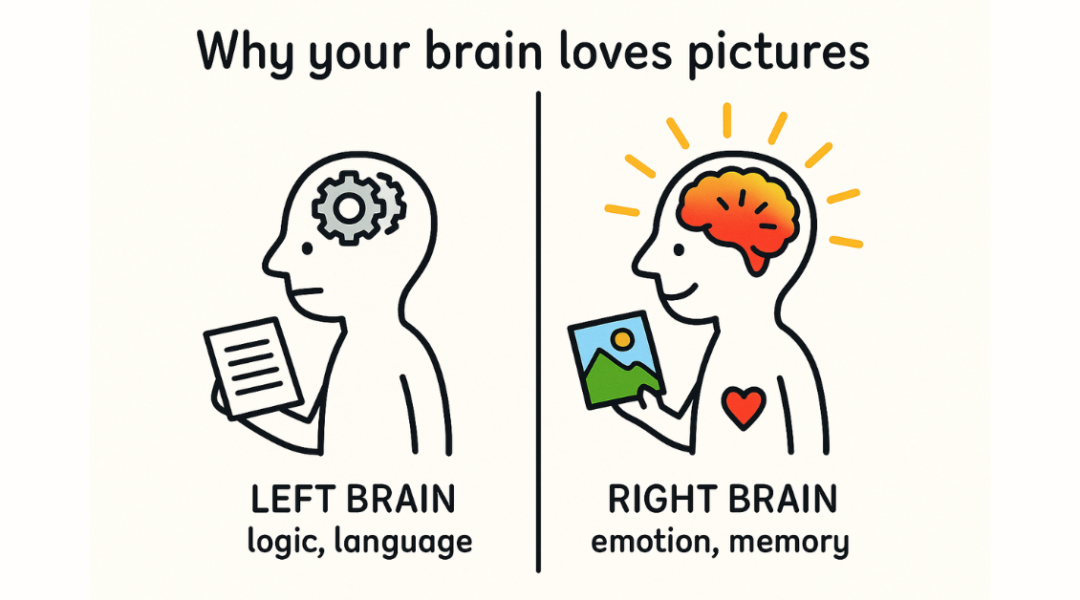Why Do We Remember Pictures Better Than Words? A Neuroscientist’s Personal Discovery
I landed at Paris-Charles de Gaulle Airport on September 11, 2001, and went to pick up my suitcase. Looking back now, I understand – why do we remember pictures better than words – because what happened next would burn into my memory forever.
Suddenly, everybody got completely silent.
The entire baggage hall fell quiet. People stared at their phones, receiving messages. Someone asked if I was safe. Safe from what?
Then I saw it. The screen showed the first live pictures of the plane hitting the tower.
Twenty-four years later, I can still see that baggage carousel. The worried faces. The exact spot where I stood.
But here’s what puzzles me: Why can I remember every detail of that moment, but not what I had for lunch last Tuesday?
Why Do We Remember Pictures Better Than Words? The Brain’s Secret
Here’s what neuroscientists discovered: When you see an image, your right hemisphere processes tens of thousands of details in milliseconds.
Reading words? That’s different. Your left hemisphere decodes them sequentially. One. After. Another.
But the real twist involves emotion. Your right brain doesn’t just process faster – it’s where emotions live. That’s why a photo of a loved one hits differently than reading their name. And why that screen in Charles de Gaulle burns in my memory forever.
Scientists call this a “flashbulb memory.” When emotional shock meets visual input, your brain photographs everything. Not just the trigger. Everything around it. The image on the screen was the match, but my brain lit up the entire scene.
Research from MIT proves the brain processes visual information in just 13 milliseconds. Meanwhile, reading and understanding text takes much longer. Your brain must decode each symbol, then link it to meaning.
The Evolution of Why Do We Remember Pictures Better Than Words
For 99% of human history, there were no words.
Think about that. Our ancestors survived by instantly recognizing threats. Tiger meant run. Berry meant eat. No time for reading. No symbols to decode.
Reading only appeared 5,000 years ago. In evolutionary terms, it’s brand new.
This explains why visual memory dominates. Studies reveal that after three days, people retain only 10% of written information. But they remember 65% of visual information. Combine visuals with text? Retention jumps to 90%.
Your brain processes visual information 60,000 times faster than text. This isn’t just interesting – it’s a survival mechanism refined over millions of years.
Why Pictures Beat Words Every Time
In 1911, newspaper editor Arthur Brisbane wrote: “Use a picture. It’s worth a thousand words.”
He underestimated. A picture isn’t worth 1,000 words. It’s worth tens of thousands.
The picture superiority effect shows that pictures get processed faster AND stored better in memory. When you see an image, your brain encodes it twice: as a visual memory and as a verbal label. Words only get one encoding – verbal.
This double encoding gives images a massive memory advantage.
How Visual Memory Shapes Your Daily Life
Think about your last scroll through social media. Which posts do you remember? The ones with compelling images, right?
This happens because visual content gets 2.3 times more engagement than text alone. People share visual content 40 times more often. And they remember 80% of what they see and do, compared to just 20% of what they read.
In education, students using visual study methods score dramatically higher on tests. Visual instructions improve performance by 323%. That’s not a typo. People following illustrated directions perform over three times better than those reading text-only instructions.
Even in business, presentations with visual aids persuade 43% more effectively. Colored visuals increase willingness to read by 80%.
Using Visual Memory to Your Advantage
So how can you harness this power?
Start with communication. Don’t just tell – show. When explaining complex ideas, use visual metaphors. Instead of describing statistics, create an infographic. Rather than listing steps, draw a flowchart.
For personal memory, try photo journaling. Take one meaningful photo each day. You’ll remember entire days better than if you wrote pages about them.
Even simple sketches activate visual memory pathways. Ancient Greeks knew this secret – they attached information to visual locations in their minds for near-perfect recall.
When Visual Memory Tricks Us
But visual memory has a dark side. Its very strength becomes a weakness.
Because images create such strong memories, they can also create false ones. Researchers studying flashbulb memories found something surprising. While people stay highly confident in their visual memories, the details often change over time.
We remember the emotional impact accurately. But we unconsciously alter the details.
This explains why eyewitness testimony feels incredibly real to the witness yet proves surprisingly unreliable. The emotion cements the memory, but the details shift.
Why Do We Remember Pictures Better Than Words in Our Screen-Filled World?
Today, we see 5,000+ marketing messages daily. Yet paradoxically, as we consume more images, each one becomes less memorable.
Understanding visual memory helps you cut through the noise. Make images emotional – bland stock photos vanish instantly. Make them relevant – your brain prioritizes information it deems important. Make them unique – novel images create stronger memory traces than familiar ones.
The Power of Visual Storytelling
That day in Paris changed everything. After the shock wore off, I visited a factory for a job interview. They offered me Marketing Director. I accepted.
I never imagined I’d one day use the power of images to help biotech companies tell their stories.
Now, when companies struggle to explain complex mechanisms, we don’t give them more words. We create visual stories that make the invisible visible. Because we understand why do we remember pictures better than words – and we use that knowledge to make life-saving science unforgettable.
Your Visual Memory at Work
Where were you on September 11? I bet you can still see yourself in that moment.
That’s visual memory’s power. It doesn’t just help us remember – it helps us understand, connect, and share experiences.
Next time you need someone to remember something important, don’t just tell them. Show them. Create an image that connects to their emotions. Make it visual, make it meaningful, and make it unforgettable.
Because now you know why do we remember pictures better than words. The question becomes: How will you use this power?

